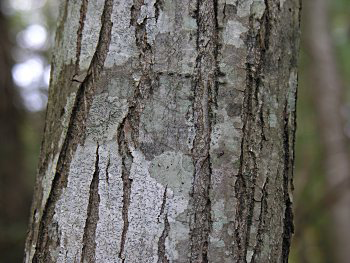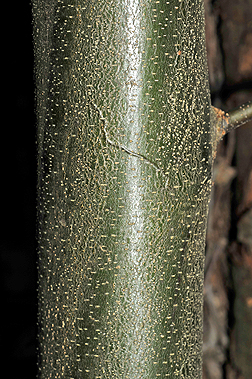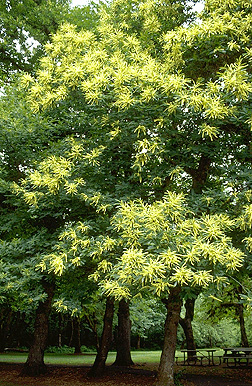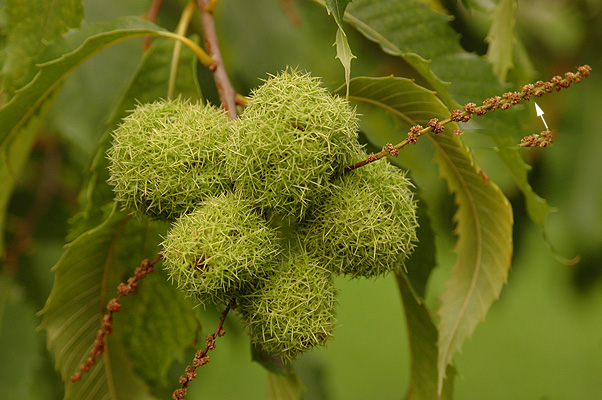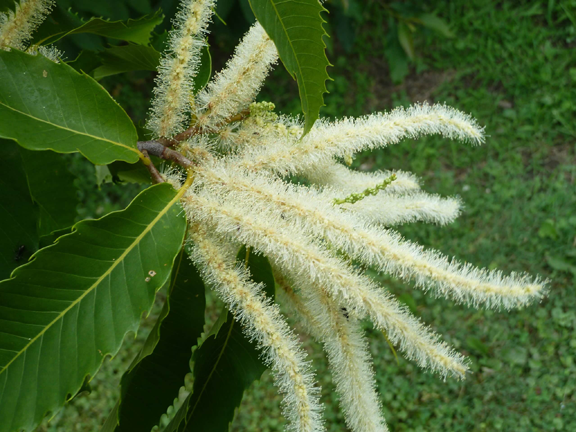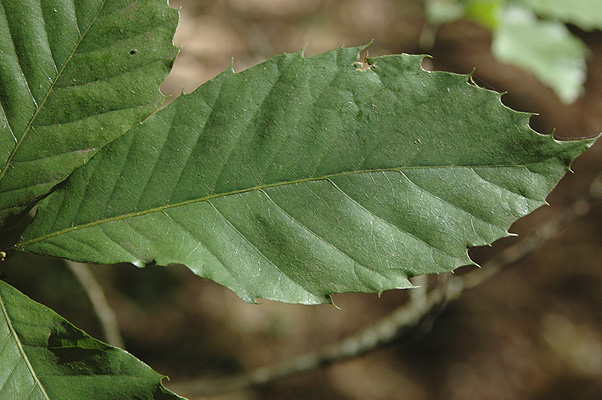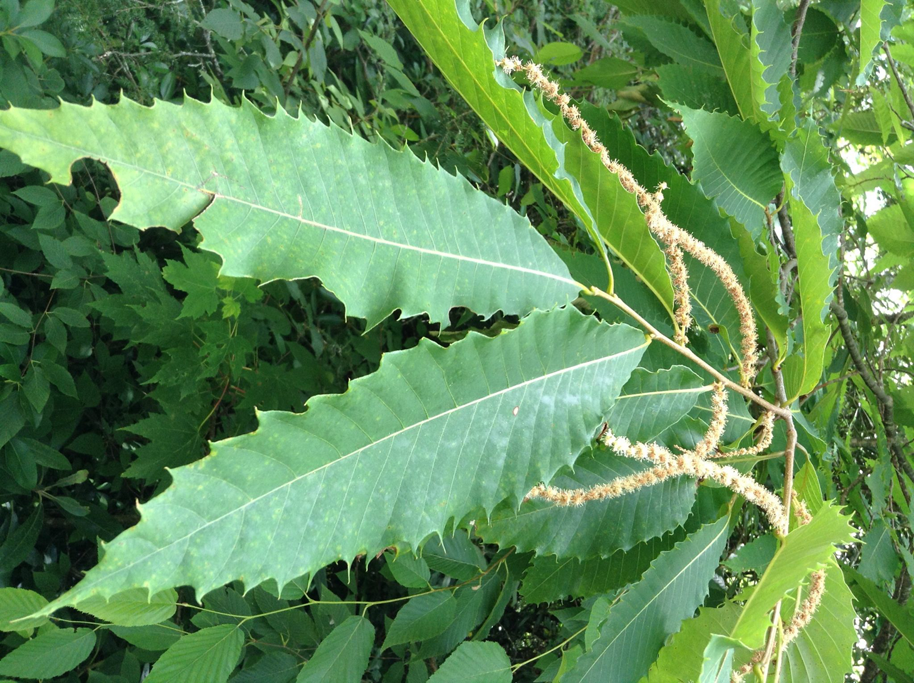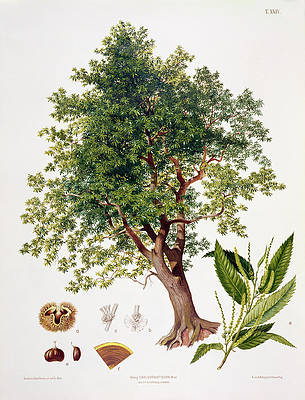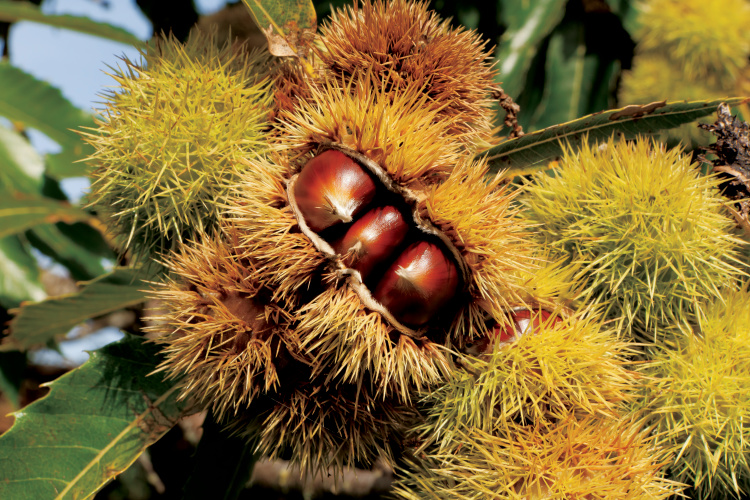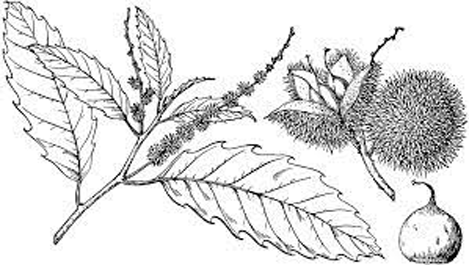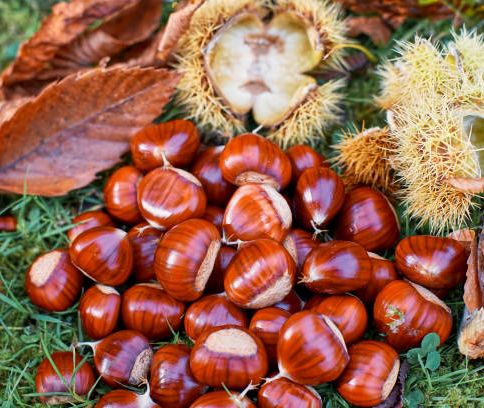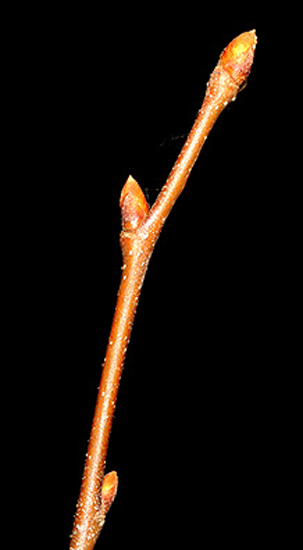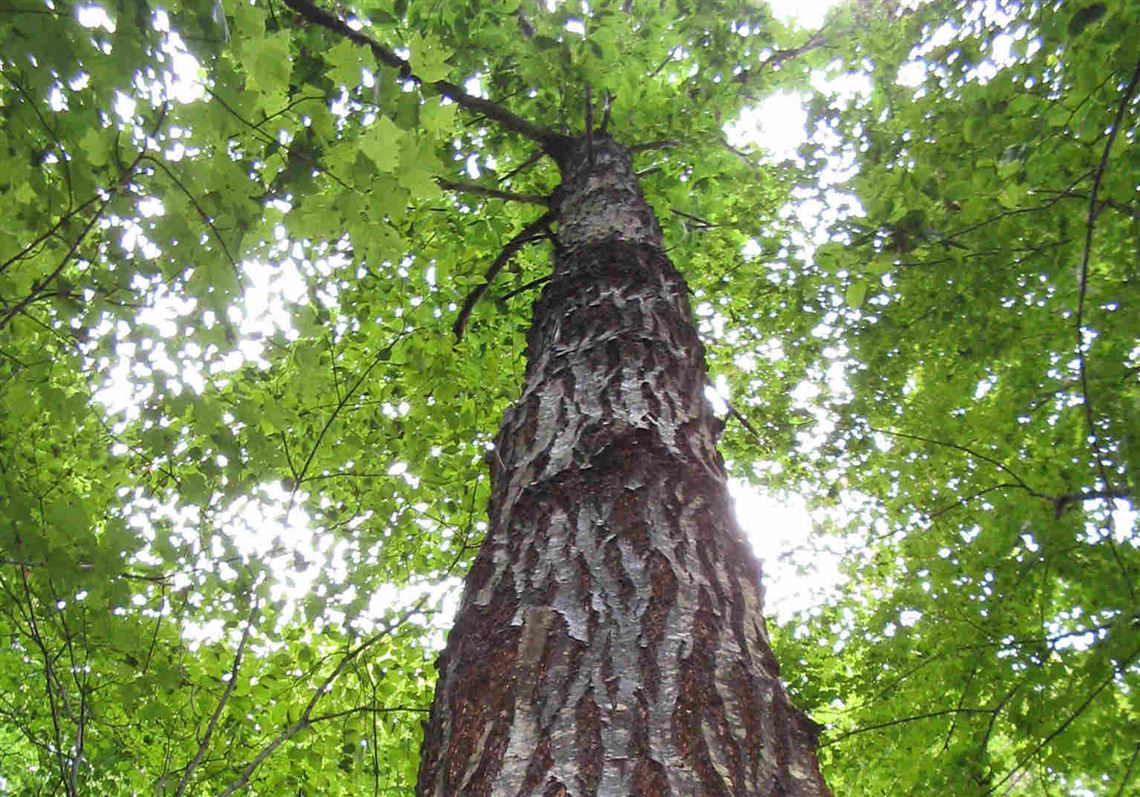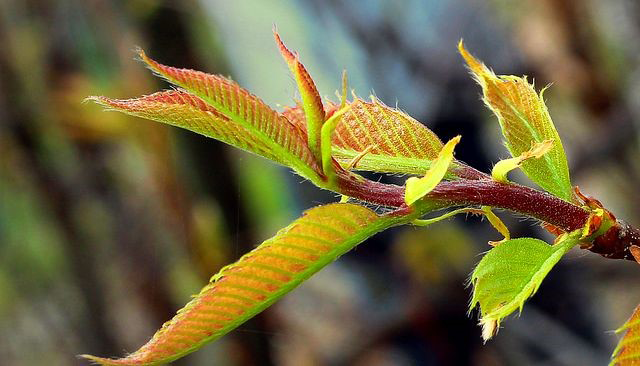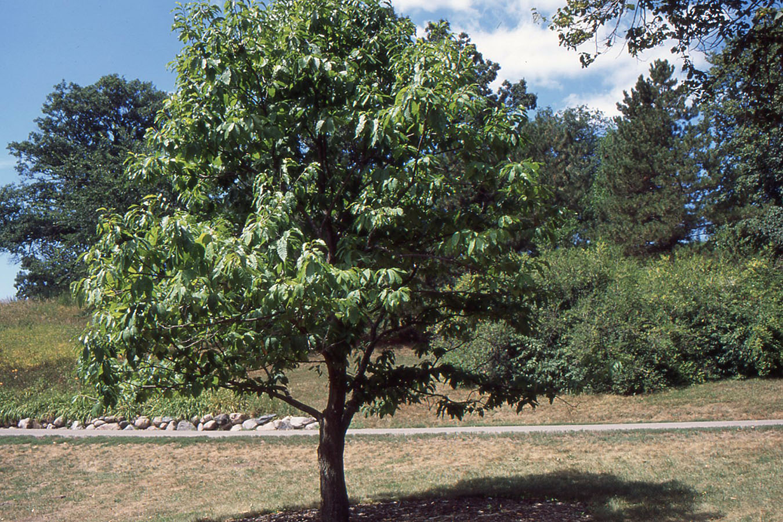
| American Chestnut Quick Facts | |
|---|---|
| Name: | American Chestnut |
| Scientific Name: | Castanea dentata |
| Origin | Georgia to Mississippi, north to southern Maine and southern Ontario |
| Colors | Dark brown or reddish brown |
| Shapes | Nuts with prickly husks that are 2-2.5 inches in diameter |
| Taste | Sweet, nutty flavor |
| Health benefits | Treat diarrhea, dysentery, constipation, fever, arthritis, tuberculosis, wounds, cancer, colds, flu, blood sugar levels, and other respiratory ailments, |
| Name | American Chestnut |
|---|---|
| Scientific Name | Castanea dentata |
| Native | Georgia to Mississippi, north to southern Maine and southern Ontario |
| Common Names | American chestnut, Toothed Chestnut, American Sweet Chestnut |
| Name in Other Languages | Bulgarian: Amerikanski kesten (Американски кестен) Catalan: Castanyer americà Chinese: Měi zhōu lì (美洲栗), Měi zhōu lì mù (美洲栗木) Czech: Kaštanovník americký, Kaštanovník zubatý Danish: Amerikansk Kastanje Dutch: Amerikaanse kastanje, Amerikaanse tamme kastanje English: American chestnut, Toothed Chestnut, American Sweet Chestnut Estonian: Ameerika kastanipuu Finnish: Amerikankastanja French: Châtaignier à feuilles dentées, Châtaignier américain, Châtaignier d’Amérique Galician: Castiñeiro americano German: Amerikanische Edelkastanie, Amerikanische Kastanie, Amerikanischer Edelkastanienbaum, Amerikanischer Kastanienbaum Greek: Amerikániki̱ kastaniá (Αμερικάνικη καστανιά), Kastaniá i̱ odonto̱tí̱ (Καστανιά η οδοντωτή) Hebrew: ערמון אמריקאי Hungarian: Amerikai gesztenye Italian: Castagno americano Japanese: Amerikan chesunatto (アメリカン・チェ スナット), Amerika guri (アメリカグリ) Korean: Mi gug bam na mu (미국밤나무) Latvian: Zobainā kastaņa Norwegian: Amerikakastanje Persian: شاهبلوط آمریکایی Polish: Kasztan amerykański, Kasztan zębaty Portuguese: Castanheiro-americano. Russian: Kashtan amerikanskij (Каштан американский), Kashtan zubchatyj (Каштан зубчатый) Spanish: Castaño americano Swedish: Amerikansk kastanj Tagalog: Amerikanong kastanyas Turkish: Amerika kestanesi Ukrainian: Amerykansʹkyj kashtan (Американський каштан), Kashtan amerykansʹkyj (Каштан американський) Vietnamese: Cây hạt dẻ Mỹ, Dẻ châu Mỹ |
| Plant Growth Habit | Rapidly–growing, large, deciduous hardwood tree |
| Growing Climates | Prefers dryer upland deciduous forests, hardwood to mixed forest with sandy, acidic to neutral soils |
| Soil | Dry, gravelly or rocky, mostly acid soils. It prefers dry or moist soil and can tolerate drought |
| Plant Size | Can grow upwards of 100 feet in height and 10 feet in diameter |
| Bark | Bark is dark grey-brown and cracks with age |
| Leaf | Leaves are mostly hairless, 15 to 30 centimeters long and five to 10 centimeters wide at maturity, with coarsely and sharply serrated edges and a long pointed tip |
| Flowering season | June – August |
| Flower | Monoecious species, which means that it has both male (staminate) and female (pistillate) flowers on the same tree. The male flowers are made up of long, thin catkins that can be anywhere from 4 to 10 inches long and grow up or outward. The female flowers of the American chestnut tree grow in groups of one to three at the base of shorter catkins, which are about 4 to 6 inches long and grow near the tips of twigs. |
| Fruit Shape & Size | Nuts with prickly husks that are 2-2.5 inches in diameter |
| Fruit Color | Dark brown or reddish brown |
| Taste | Sweet, nutty flavor |
| Lifespan | 400 to 600 years |
| Season | September – October |
| Varieties |
|
| Health Benefits |
|
| Culinary Uses |
|
Plant Description
The American chestnut tree is a beautiful thing to see. This tall hardwood tree can grow up to 100 feet tall. It has a cylinder-shaped trunk and a wide, spreading top that gives a lot of shade. It is a fast-growing deciduous tree that does well in dry deciduous mountain forests and hardwood to mixed forests with sandy, acidic to neutral soils. The American chestnut grows best in dry, gravelly or rocky, mostly acidic soils, and it can even survive drought. This tree can live in a wide range of soil types and moisture levels because it has deep taproots. The American chestnut tree is a great choice for your landscape, whether you want to add a natural point of interest or just enjoy the beauty of a healthy environment.
Twig
The American chestnut tree has twigs that are about as thick as a pencil and are either chestnut or orange-brown in color. There are a lot of lighter spots on them. The tree’s flowers are also about 1/4 inch long and have an orange-brown color. They have two or three scales on them, which make them look like a seed of wheat. The fact that these buds are slightly off-center from the leaf scar makes the American chestnut tree even more interesting and unique.
Bark
When the American chestnut tree is young, the bark is smooth and a color called “chestnut brown.” As the tree gets older, the bark gets shallow cracks that look like flat lines. Older trees grow large, intertwining ridges and furrows that give them a unique, textured look. But when the tree has blight, the bark becomes bowed and split, and there are often orange fruiting bodies on the bark. This is a clear sign that a tree is sick. People often say that the bark has a “diamond” design, which adds to the beauty of the tree. Even though blight is a danger, the American chestnut tree is still a popular and well-known tree that adds beauty and character to any landscape.
Leaves
On the buds and young shoots of the American chestnut tree, the leaves alternate in two rows. They are between 4 and 9 inches long and 112 to 3 inches wide. They are elliptic-oblong in shape, with 12 to 20 big, curved teeth on both sides. The tips of these teeth are bristly, which gives the leaves a different feel. The top side of the leaves is yellowish green to dark green, while the bottom side is pale yellowish green to green. On both sides of the leaf, there are no hairs. The leaf veins are pinnate, and there are 12–20 straight veins on each side. The bases of the leaves are either narrowly round or shaped like a wedge, but the tips are sharp. The thin petioles that connect the leaves to the branches can be either light green or light yellow or smooth or have a few hairs on them. Overall, the American chestnut tree’s leaves are one of its most beautiful and recognizable features.
Flower
The American chestnut tree is a monoecious species, which means that it has both male (staminate) and female (pistillate) flowers on the same tree. The male flowers are made up of long, thin catkins that can be anywhere from 4 to 10 inches long and grow up or outward. Along the length of each catkin, these flowers are arranged in groups that are broken up. Each male flower is about 5 mm long and white. It has a head with six lobes and several stamens that stick out.
The female flowers of the American chestnut tree grow in groups of one to three at the base of shorter catkins, which are about 4 to 6 inches long and grow near the tips of twigs. They can also grow in groups of one or two on short spurs of branches. Each group of female flowers is inside a 10 mm long, spiny involucre, which is the young husk. Each involucre has anywhere from 2 to 5 female flowers. Each female flower has a calyx that has six leaves and a pistil that has a thin style. The American chestnut tree blooms from the beginning to the middle of summer for about two weeks. Cross-pollination can happen either by the wind or by insects. Because of this, this species is an important part of the ecosystem because it provides food for many insects. This improves the health and diversity of the environment as a whole.
Fruit
When the male flowers of this plant fertilize the female flowers, nuts with prickly husks that are 2-2.5 inches in diameter grow from the female flowers. Each husk holds one to three nuts, but sometimes there are four or five. In the fall, the husk splits into four parts to release the nuts. The nuts that are ready to be eaten are about 3/4 of an inch long, dark brown or reddish brown, round or oval, and pointy on one end. The weight from the nuts next to it often changes the shape of the nut, flattening one or two sides. The meaty, mild, and sweet center of the nuts is a good source of food for both animals and people.
History
The American chestnut tree used to be a very important species in the eastern United States because its wood could be used for many different things, like furniture, building materials, and fuel. The tree’s nuts were also an important food source for both people and animals. In the early 1900s, a fungus called chestnut blight was brought to the United States. It quickly spread throughout the range of the American chestnut, killing millions of trees. By the 1950s, this terrible disease had killed almost all of the old American chestnut trees.
Known Varieties and Their Characters
Both traditional breeding and transgenic methods have been used to try to bring back the American chestnut tree.
1. Dwarf chestnut (Castanea pumila)
People often call this type of tree chinkapin, chinquapin, or the American chinquapin. Its leaves are a dark green color, and if they are in the sun, they have fine hairs on the bottom. The tree has purple branches with dark red buds that end in sharp points. It only makes one sweet nut. This type of tree is resistant to rot to a certain degree.
2. Japanese chestnut (Castanea crenata)
The leaves of the Japanese chestnut tree have sharp edges, glands, and fine hairs on the back when they are in the sun. It has pink to light red branches with big white lenticels and round, shiny brown buds. The tree makes groups of two or three nuts, but they don’t taste very sweet. Even so, in Japan they are still a famous seasonal ingredient. The Japanese chestnut tree has a moderate ability to fight blight.
3. Chinese chestnut (Castanea mollissima)
The Chinese chestnut type can be told apart by its leaves, which have teeth on the edges and hairs on the undersides when they are in the sun. It has tan or pea-green twigs with yellow spots that look like ellipses. The flowers are round, and they can be tan, dark brown, or even black. They also have hairs on them. This type makes between two and three clusters of nuts that taste sweet. Chinese chestnuts don’t get rot very often. This type of tree is very different from the American chestnut in terms of how it looks. A mature Chinese chestnut tree is about the same size as a big old apple tree. It grows between 40 and 60 feet tall and has the same width. Even though the two species look different, they can be mixed to make hybrid offspring.
4. European chestnut (Castanea sativa)
The tips of the European chestnut tree’s leaves are toothed, and when the leaves are in the sun, some of them get hairy and some don’t. The twigs of the tree are strong and dark brown, and they have white dots on them called lenticels. The flowers look like round balls and are a dark red color. The European chestnut tree makes clusters of two to three nuts that are starchy. This variety has only a small amount of protection to blight.
Health benefits of American Chestnuts
Several native tribes have used the American chestnut tree as a medicine for hundreds of years. Even though the tree is best known for its tasty nuts, its leaves, bark, and nuts have been used to treat a number of health problems. Here are some of the ways the American chestnut can help your health.
1. Anti-inflammatory properties
Tannins, which are found in the American chestnut, help reduce inflammation. These qualities can help reduce inflammation and ease pain caused by diseases like arthritis.
2. Digestive aid
Because they have a lot of fiber, the nuts of the American chestnut have been used as a natural way to help with digestion. They can help with digestion and keep you from getting constipated.
3. Anti-viral properties
There is a substance called beta-sitosterol in the wood of the American chestnut that fights viruses. This trait can help the body fight off viruses like the cold and flu.
4. Wound healing
In the past, the bark of the American chestnut was used to heal wounds naturally. It has chemicals in it that help speed up the mending process and lower the risk of getting an infection.
5. Respiratory health
People with breathing problems like pneumonia and asthma have used the leaves of the American chestnut to help them feel better. They have chemicals in them that can help open up the lungs and make it easier to breathe.
6. Cardiovascular health
Flavonoids, which are found in the American chestnut, have been shown to improve heart health. Flavonoids like these can help lower the chance of heart disease and stroke.
7. Antioxidant properties
The American chestnut has a lot of antioxidants, which can help protect the body from the damage that free radicals can do. Cancer and heart disease are just two of the health problems that have been linked to free radicals.
8. Immune system booster
Vitamin C, which is found in the American chestnut, can help the nervous system. A strong immune system can help the body fight off diseases and viruses.
9. High in fiber
There is a lot of fiber in American chestnuts, which can help with digestion and regular bowel motions.
10. Rich in vitamins and minerals
These nuts are a good source of important vitamins and minerals, like magnesium, potassium, and iron, which are needed to stay healthy.
11. Regulates blood pressure
Potassium is an important element that helps control blood pressure. The American chestnut is a great source of potassium.
Traditional uses and benefits of American chestnuts
- The leaves can be steeped in warm water to calm nerves in the lungs and make it easier to cough up mucus.
- People used to drink a tea made from the leaves to treat whooping cough, but experts now think that they only have mildly drying effects.
- Native people used the American chestnut to treat coughs, rashes, and heart problems, among other things.
- People used the bark of the American chestnut to treat diarrhea, dysentery, fever, and as an astringent and salve to heal wounds.
- Tea made from American chestnut leaves was used to treat colds, flu, and other lung diseases.
- People thought that eating raw or roasted American chestnut nuts would help with constipation and make nursing moms make more milk.
- Broken bones were fixed with splints made from the wood.
- The bark is used in traditional medicine to treat dysentery, asthma, and even cancer.
- The nuts of the American chestnut tree are also used to boost the defense system and keep blood sugar levels in check.
- Native American groups made tea or poultices from the bark to treat a wide range of illnesses.
- American chestnuts can help coughs go away and help people with arthritis.
- They also help reduce swelling and can soothe sore lips and swollen body parts.
Culinary Uses
Because they taste sweet and salty and have a creamy texture, American chestnuts can be used in many different ways in the kitchen. Here are a few famous ways to use American chestnuts in food:
- Roasting: It’s easy and delicious to roast chestnuts. Score the chestnuts’ shells with a knife, and then roast them in the oven or on the stove until the shells turn black and the nuts are soft and tender.
- Stuffing: Chestnuts are a great thing to put in stuffing because they add a delicious sweet flavor and a smooth, creamy texture. They go especially well with ham or chicken.
- Soups and stews: Chestnuts are an item that can be used in a lot of different ways. They can add depth and richness to soups and stews. They go well with veggies that grow in the fall, like butternut squash and carrots.
- Purees and sauces: By pureeing chestnuts, you can make delicious sauces or spreads. These go well with game foods like venison or wild boar.
- Baked goods: If you grind chestnuts into flour, you can use that instead of regular flour in baking. This replacement gives cakes, muffins, and other baked goods a unique nutty flavor and a moist, tender texture.
- Candied: One way to candy chestnuts is to boil them in sugar syrup. This makes a tasty treat with a sweet, crunchy outside and a soft, creamy inside. You can eat candied chestnuts as a snack on their own, or you can use them to decorate sweets like ice cream or cake.
Other Facts
- The bark, dried leaves, wood, and seed husks of the chestnut tree are all good places to find tannin.
- The dried leaves have about 9% tannin in them, while the husks have 10-13%.
- Brown dye can be made from the bark.
- In addition to having tannins, the chestnut tree has wood that is easy to split and can be used for many things, such as cheap furniture, fence posts, telephone poles, railroad ties, and building materials.
- The American chestnut tree has a special place in American culture.
- It has been praised in writing, music, and art for its beauty, usefulness, and symbolic meaning.
Precautions
- If chestnuts are eaten wrong or too much, they can cause stomach problems.
- Also, kidney trouble, cancer, and liver damage could be possible side effects.
References:
https://www.itis.gov/servlet/SingleRpt/SingleRpt?search_topic=TSN&search_value=19454#null
https://pfaf.org/user/Plant.aspx?LatinName=Castanea+dentata
https://www.missouribotanicalgarden.org/PlantFinder/PlantFinderDetails.aspx?taxonid=280744
https://gd.eppo.int/taxon/CSNDE
http://www.theplantlist.org/tpl1.1/record/kew-34965
https://en.wikipedia.org/wiki/American_chestnut
https://www.illinoiswildflowers.info/trees/plants/am_chestnut.html
https://plants.usda.gov/home/plantProfile?symbol=CADE12


